Access to outdoor recreation by older people in Scotland
Report detailing research on access to outdoor recreation for older people.
Appendix B: Mapping and spatial analysis by age and disability - additional indicators
Household population aged 65 or over and living alone
Table B.1.: Household population aged 65 or over and living alone.
| Region | Total household population | Household population aged 65 or over and living alone | Household population aged 65 or over and living alone (% of expected) | Living alone (% of household population aged 65 or over) | % of Scotland household population | % of Scotland household population aged 65 or over and living alone |
|---|---|---|---|---|---|---|
| Very Remote Rural | 159,593 | 11,163 | 116.55 | 32.52 | 3.07 | 3.58 |
| Remote Rural | 165,152 | 10,453 | 105.46 | 30.88 | 3.18 | 3.35 |
| Accessible Rural | 577,956 | 29,936 | 86.30 | 29.27 | 11.12 | 9.60 |
| Very Remote Small Towns | 66,385 | 4,946 | 124.14 | 40.07 | 1.28 | 1.59 |
| Remote Small Towns | 132,093 | 10,084 | 127.20 | 36.68 | 2.54 | 3.23 |
| Accessible Small Towns | 466,554 | 28,330 | 101.18 | 34.35 | 8.98 | 9.08 |
| Other Urban Areas | 1,614,911 | 94,538 | 97.54 | 36.06 | 31.08 | 30.31 |
| Large Urban Areas | 2,013,742 | 122,417 | 101.29 | 40.91 | 38.75 | 39.25 |
A further subset of older residents - those who were living alone in one person households - shows some patterns in common with the other age-related variables, in particular the 'remoteness effect' described earlier. The number of older residents living alone was well below that expected in accessible rural areas, and was well above expected in remote and very remote small towns. In urban areas and in accessible small towns, the number of people aged 65 or over and living alone was very close to that expected ( i.e. national average). At this regional level, the proportion of older household residents who lived alone was relatively lowest in the three rural areas, and highest in large urban areas and very remote small towns. Figure B.1. supports the regional breakdown above, as there are prominent concentrations of dark blue data zones (where the number of people that were older and living alone was half that expected or below) in areas surrounding the central belt, Aberdeen and Inverness. Higher than expected values appear associated with some more remote areas (the far north, parts of Argyll and Bute, and the Western Isles) and dark red data zones (more than double the expected population with this protected characteristic) are concentrated in the four largest cities.
Figure B.1.: Household population aged 65 or over and living alone, Scotland.
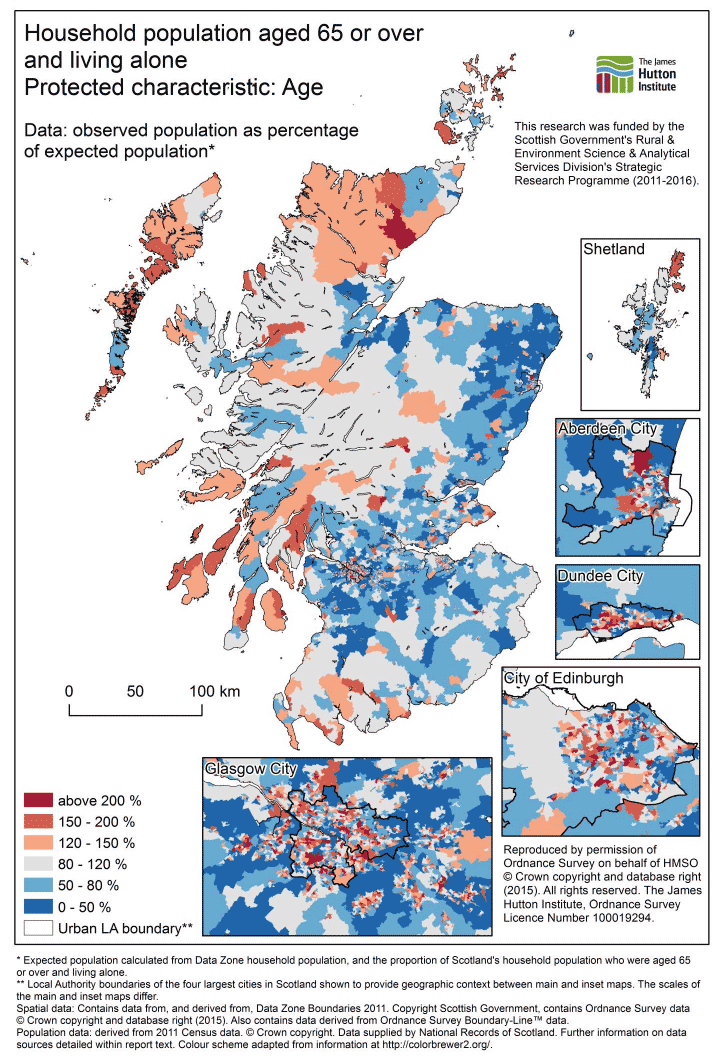
Male and female populations aged 65 or over
Table B.2.: Male and female populations aged 65 or over.
| Region | Total population | Male population aged 65 or over | Female population aged 65 or over | Male population aged 65 or over (% of expected) | Female population aged 65 or over (% of expected) | Female population (% of 65 or over population) | % of Scotland population | % of Scotland population - male and aged 65 or over | % of Scotland population - female and aged 65 or over |
|---|---|---|---|---|---|---|---|---|---|
| Very Remote Rural | 162,017 | 16,305 | 18,904 | 138.87 | 121.96 | 53.69 | 3.06 | 4.25 | 3.73 |
| Remote Rural | 168,013 | 16,275 | 18,749 | 133.67 | 116.65 | 53.53 | 3.17 | 4.24 | 3.70 |
| Accessible Rural | 588,757 | 49,026 | 56,328 | 114.91 | 100.01 | 53.47 | 11.12 | 12.78 | 11.12 |
| Very Remote Small Towns | 67,549 | 5,432 | 7,556 | 110.97 | 116.93 | 58.18 | 1.28 | 1.42 | 1.49 |
| Remote Small Towns | 134,493 | 12,410 | 16,692 | 127.33 | 129.73 | 57.36 | 2.54 | 3.23 | 3.29 |
| Accessible Small Towns | 472,352 | 37,145 | 48,184 | 108.52 | 106.63 | 56.47 | 8.92 | 9.68 | 9.51 |
| Other Urban Areas | 1,640,430 | 117,714 | 156,558 | 99.02 | 99.76 | 57.08 | 30.98 | 30.68 | 30.90 |
| Large Urban Areas | 2,061,792 | 129,432 | 183,624 | 86.63 | 93.09 | 58.66 | 38.94 | 33.73 | 36.25 |
Statistics on the distribution of people who in 2011 were a) aged 65 or over and male and b) aged 65 or over and female, broadly mirror the distribution of the overall older population. However, there are some interesting differences between the distributions of older men and older women, which are especially noticeable in rural areas. Older groups of both genders were particularly over-represented in very remote and remote rural areas, and remote small towns. However, in rural areas, the difference is greater for older men than it is for older women: in very remote rural areas the population of older men was 139% that expected (respective figure for older women: 122%), with a similar difference in remote rural areas. Therefore, while remote and very remote rural areas had higher than expected numbers of older residents, older men were particularly over-represented in these areas. More detailed mapping shows that 'dark red' data zones (with more than double the expected number of older men) are found in more remote rural areas of Scotland, such as areas of Dumfries and Galloway and the Borders, areas of the Highlands and Islands and west coast (Figure B.2.). However, the numbers of older women do not appear to be as far above expected values in the same regions (Figure B.3.). The maps also indicate that in some areas which are closer to cities (including Aberdeenshire and the area to the south of the central belt), there are several 'blue' data zones where the population of older women was below that expected, but in the same areas the population of older men was much closer to the expected population. This pattern is reflected to some extent in the overall statistics for accessible rural areas (Table B.2.).
Figure B.2.: Male population aged 65 or over, Scotland.
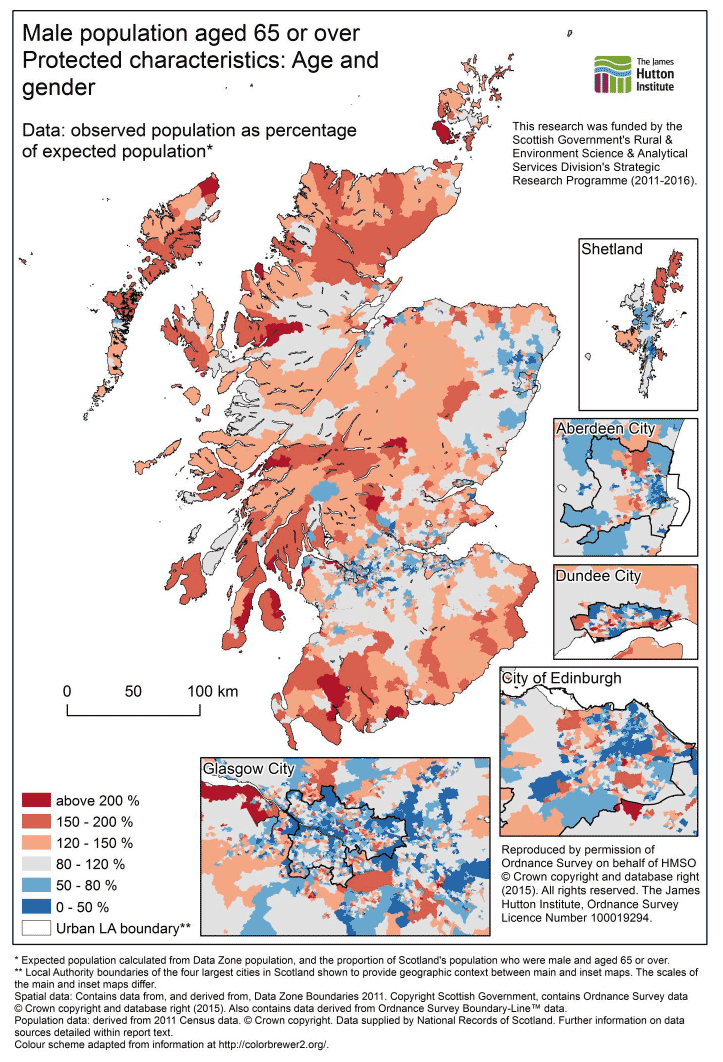
Figure B.3.: Female population aged 65 or over, Scotland.
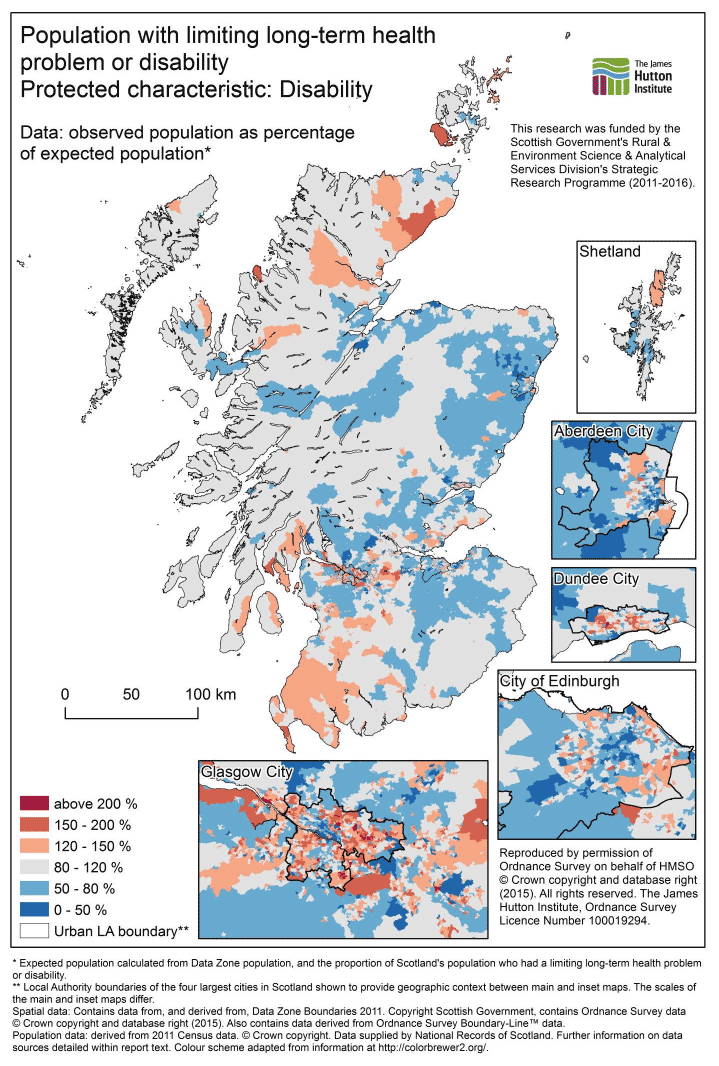
Population with limiting long-term health problem or disability
Table B.3.: Population with limiting long-term health problem or disability.
| Region | Total population | Population with limiting condition/disability | Population with limiting condition/disability (% of expected) | % of Scotland population | % of Scotland population with limiting condition/disability |
|---|---|---|---|---|---|
| Very Remote Rural | 162,017 | 32,002 | 100.54 | 3.06 | 3.08 |
| Remote Rural | 168,013 | 32,659 | 98.94 | 3.17 | 3.14 |
| Accessible Rural | 588,757 | 104,842 | 90.64 | 11.12 | 10.08 |
| Very Remote Small Towns | 67,549 | 13,493 | 101.67 | 1.28 | 1.30 |
| Remote Small Towns | 134,493 | 28,174 | 106.63 | 2.54 | 2.71 |
| Accessible Small Towns | 472,352 | 92,003 | 99.14 | 8.92 | 8.84 |
| Other Urban Areas | 1,640,430 | 328,364 | 101.88 | 30.98 | 31.56 |
| Large Urban Areas | 2,061,792 | 408,834 | 100.93 | 38.94 | 39.30 |
Among the eight regions of Scotland, the numbers of residents whose day-to-day lives were affected by a long-term health problem or disability in 2011 generally are much closer to expected ( i.e. national) values than they are for the age-related variables. The distribution of Scotland's population with a limiting condition was very similar to that of Scotland's total population. However, this indicator suggests that accessible rural areas were the 'healthiest' region of Scotland, as the number of people with a limiting condition was over 9% lower than expected, a figure below that of any other region, and remote small towns were the least 'healthy' region overall. Figure B.4. shows a) the relatively low variation in populations with long-term conditions from expected values, and b) a tendency for data zones in some areas surrounding large cities (Aberdeenshire, Inverness, areas to the south of Glasgow and Edinburgh, and the Dunbartonshires and Stirling) to have lower than expected populations with long-term health conditions. Data zones in Greenock and traditionally deprived areas of Glasgow ( e.g. Gorbals/Hutchesontown, Shettleston/Parkhead, Glenwood/Castlemilk) are particularly prominent among those data zones where incidence of long-term conditions was more than double that expected.
Figure B.4.: Population with limiting long-term health problem or disability, Scotland.
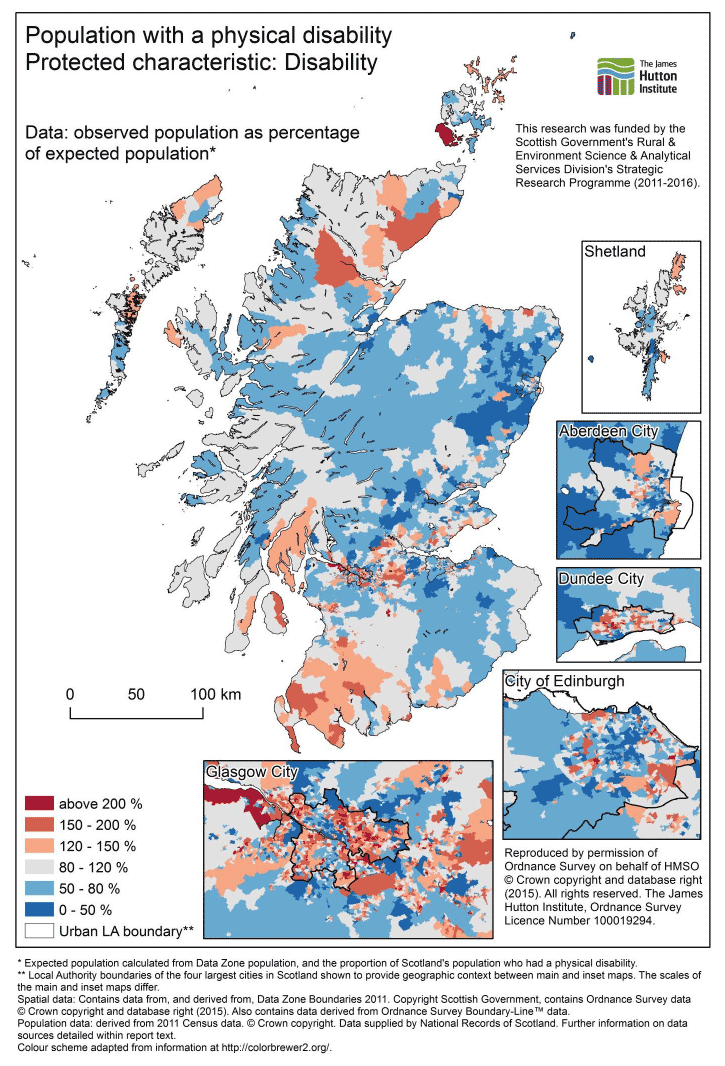
Population with a physical disability
Table B.4.: Population with a physical disability.
| Region | Total population | Population with physical disability | Population with physical disability (% of expected) | % of Scotland population | % of Scotland population with physical disability |
|---|---|---|---|---|---|
| Very Remote Rural | 162,017 | 10,614 | 97.67 | 3.06 | 2.99 |
| Remote Rural | 168,013 | 10,974 | 97.38 | 3.17 | 3.09 |
| Accessible Rural | 588,757 | 35,490 | 89.87 | 11.12 | 9.99 |
| Very Remote Small Towns | 67,549 | 4,686 | 103.43 | 1.28 | 1.32 |
| Remote Small Towns | 134,493 | 9,495 | 105.26 | 2.54 | 2.67 |
| Accessible Small Towns | 472,352 | 31,785 | 100.32 | 8.92 | 8.95 |
| Other Urban Areas | 1,640,430 | 113,847 | 103.47 | 30.98 | 32.05 |
| Large Urban Areas | 2,061,792 | 138,291 | 100.00 | 38.94 | 38.94 |
Across the eight regions of Scotland, populations who reported a physical disability do not differ greatly relative to expected ( i.e. national) values, except in accessible rural areas, where the number of people affected by a disability was 10% lower than expected. It is notable that all three types of rural areas had smaller than expected populations with physical disabilities, and populations in all types of small town were more affected by physical disability than those of respective rural areas. Figure B.5. shows the large physical area covered by data zones in rural areas with below-expected populations of physically disabled people, with 'dark blue' data zones (where disabled populations were half expected populations, or less) located in closer proximity to some of the larger cities. There are 172 data zones where the disabled population (by this indicator) was double that expected: these are not prominent on the main map, but the inset map of Glasgow shows the concentration of far above expected values in that area. Two data zones classified as remote small towns at Newton Stewart (S01007517) and Dunoon (S01007366) have physically disabled populations which are more than two and a half times expected.
Figure B.5.: Population with a physical disability, Scotland.
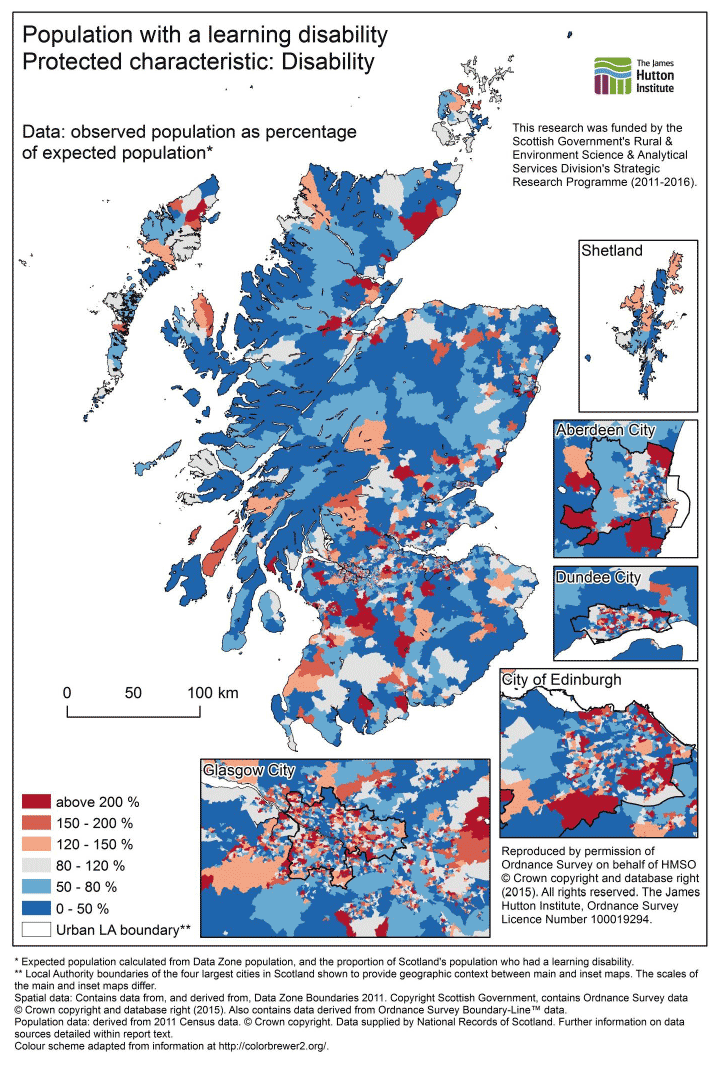
Population with a learning disability
Table B.5.: Population with a learning disability.
| Region | Total population | Population with learning disability | Population with learning disability (% of expected) | % of Scotland population | % of Scotland population with learning disability |
|---|---|---|---|---|---|
| Very Remote Rural | 162,017 | 580 | 71.95 | 3.06 | 2.20 |
| Remote Rural | 168,013 | 709 | 84.81 | 3.17 | 2.69 |
| Accessible Rural | 588,757 | 2,527 | 86.26 | 11.12 | 9.59 |
| Very Remote Small Towns | 67,549 | 341 | 101.45 | 1.28 | 1.29 |
| Remote Small Towns | 134,493 | 830 | 124.03 | 2.54 | 3.15 |
| Accessible Small Towns | 472,352 | 2,219 | 94.41 | 8.92 | 8.42 |
| Other Urban Areas | 1,640,430 | 8,527 | 104.47 | 30.98 | 32.36 |
| Large Urban Areas | 2,061,792 | 10,616 | 103.48 | 38.94 | 40.29 |
Summary statistics for the eight Scottish regions related to the distribution of people who had learning disabilities show much greater variation than for other disability measures. All types of rural areas had much smaller than expected populations with a learning disability (markedly so for very remote rural areas). There is a particularly large contrast between the population who had a learning disability in remote small towns (124% of the expected population) and that in corresponding rural areas (85% of the expected population). However, these differences should be placed in the context of the very small overall numbers of people with learning disabilities (2,460) who lived in remote and very remote small towns and rural areas in 2011. Learning disabilities were relatively over-represented in both types of urban areas. Figure B.6. shows a highly varied pattern, but rural data zones in remote regions, including the western coast and islands and a large area of the Scottish Highlands and far north had well below expected numbers of people with a learning disability. Some of the very extreme data zone-level values could reflect the location of specialist schools and facilities. Data zones in affluent areas to the west of Aberdeen (S01006524, S01006516, S01006512) have extremely high values.
Figure B.6.: Population with a learning disability, Scotland.

Hospital admissions with a diagnosis of coronary heart disease
Table B.6.: Hospital admissions with a diagnosis of coronary heart disease.
| Region | Total population | Total hospital admissions with CHD diagnosis | Total hospital admissions with CHD diagnosis (% of expected) | % of Scotland population | % of Scotland's hospital admissions with CHD diagnosis |
|---|---|---|---|---|---|
| Very Remote Rural | 160,772 | 945 | 120.30 | 3.03 | 3.64 |
| Remote Rural | 182,949 | 926 | 103.59 | 3.44 | 3.57 |
| Accessible Rural | 642,653 | 2,910 | 92.67 | 12.09 | 11.21 |
| Very Remote Small Towns | 68,037 | 487 | 146.49 | 1.28 | 1.88 |
| Remote Small Towns | 124,252 | 777 | 127.98 | 2.34 | 2.99 |
| Accessible Small Towns | 456,662 | 2,337 | 104.74 | 8.59 | 9.00 |
| Other Urban Areas | 1,615,398 | 7,886 | 99.91 | 30.40 | 30.38 |
| Large Urban Areas | 2,062,877 | 9,688 | 96.12 | 38.82 | 37.32 |
The expected number of hospital admissions with a diagnosis of coronary heart disease was calculated from each region's total population and the ratio between the total number of such hospital admissions in Scotland and the total Scottish population. The figures in Table B.6. show that although actual numbers of hospital admissions by residents of remote and very remote small towns, and very remote rural areas, were much lower than in other areas, they were well above expected numbers based on population size. This is particularly the case in very remote small towns. There were fewer than expected hospital admissions for residents of accessible rural areas. Although a large majority of all hospital admissions with a diagnosis of coronary heart disease were from residents of urban areas, the overall numbers of admissions were not above those expected. Supporting the overall regional figures, Figure B.7. shows that some data zones whose populations had double the expected number of admissions are located in relatively remote areas, including the far south west, west coast, far north and parts of islands. Rural areas nearer to the central belt ( e.g. parts of Fife, Stirling, Perth and Kinross and areas to the south of Glasgow and Edinburgh) have a clustering of "blue" data zones with far below expected numbers of hospital admissions. Aberdeen, Glasgow and Dundee contain several data zones with double the expected number of admissions, but these are less prevalent in Edinburgh. Among the most extreme data zone level values, there is a cluster of four data zones at the very remote small town of Wick where the number of hospital admissions related to coronary heart disease is more than three times the expected number.
Figure B.7.: Hospital admissions with a diagnosis of coronary heart disease, Scotland.
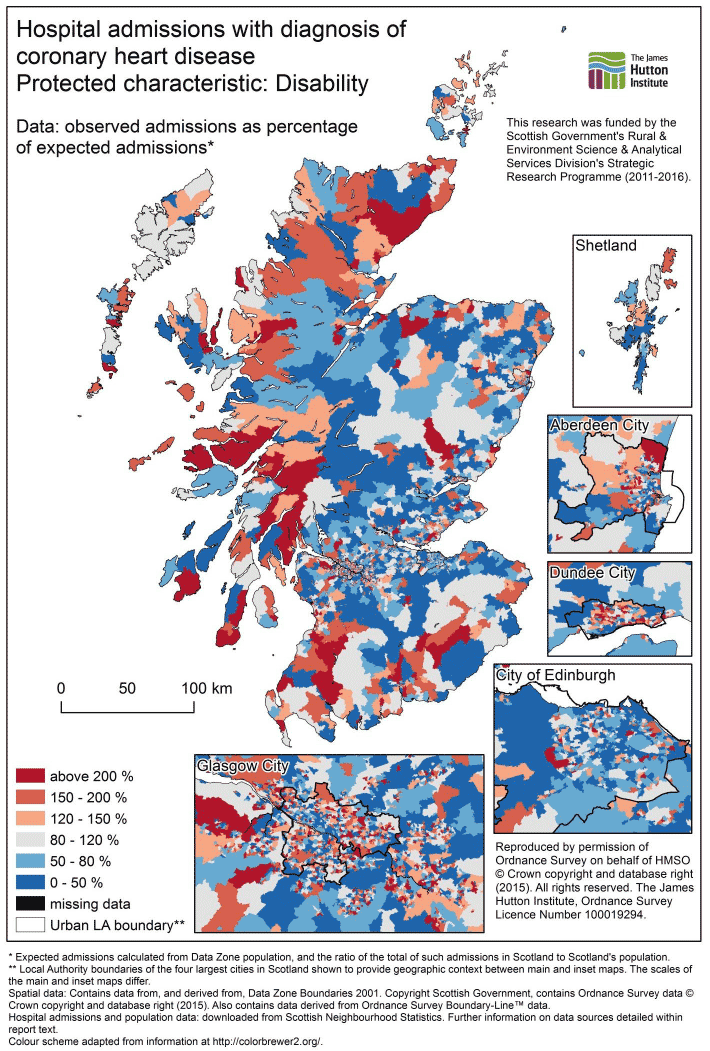
Hospital admissions with a diagnosis of cancer
Table B.7.: Hospital admissions with a diagnosis of cancer.
| Region | Total population | Total hospital admissions with cancer diagnosis | Total hospital admissions with cancer diagnosis (% of expected) | % of Scotland population | % of Scotland's hospital admissions with cancer diagnosis |
|---|---|---|---|---|---|
| Very Remote Rural | 160,772 | 4,672 | 108.88 | 3.03 | 3.29 |
| Remote Rural | 182,949 | 5,163 | 105.73 | 3.44 | 3.64 |
| Accessible Rural | 642,653 | 16,004 | 93.30 | 12.09 | 11.29 |
| Very Remote Small Towns | 68,037 | 1,658 | 91.30 | 1.28 | 1.17 |
| Remote Small Towns | 124,252 | 3,594 | 108.37 | 2.34 | 2.53 |
| Accessible Small Towns | 456,662 | 12,504 | 102.59 | 8.59 | 8.82 |
| Other Urban Areas | 1,615,398 | 39,879 | 92.49 | 30.40 | 28.12 |
| Large Urban Areas | 2,062,877 | 58,328 | 105.94 | 38.82 | 41.13 |
The regional pattern for hospital admissions with a diagnosis of cancer (Table B.7.) is noticeably different from that of admissions with a diagnosis of coronary heart disease. Differences between observed numbers of admissions and expected numbers were not as large for residents of remote and very remote areas, and the admissions of residents in very remote small towns were noticeably below expected numbers, as opposed to being far above them for coronary heart disease admissions. Hospital admissions with a cancer diagnosis were over-represented among residents of large urban areas, remote and very remote rural areas, and remote small towns; and were under-represented among residents of accessible rural areas and other urban areas. Spatially, there is a more mixed pattern related to admissions with a diagnosis of cancer (Figure B.8.) than for coronary heart disease (Figure B.7.), although data zones with double the expected number of admissions are prominent across more remote areas, including the west coast, western islands and parts of the Highlands, south west and Borders regions. Perth and Kinross, Angus, Fife and Stirling contain data zones with far below expected numbers of admissions, and the Dumfries and Galloway area contains several data zones where admissions were far below expected. Notably, the City of Edinburgh local authority has several "red" data zones within it, while Aberdeen and Dundee City do not: these observations contrast with those for admissions with a diagnosis of coronary heart disease.
Figure B.8.: Hospital admissions with a diagnosis of cancer, Scotland.
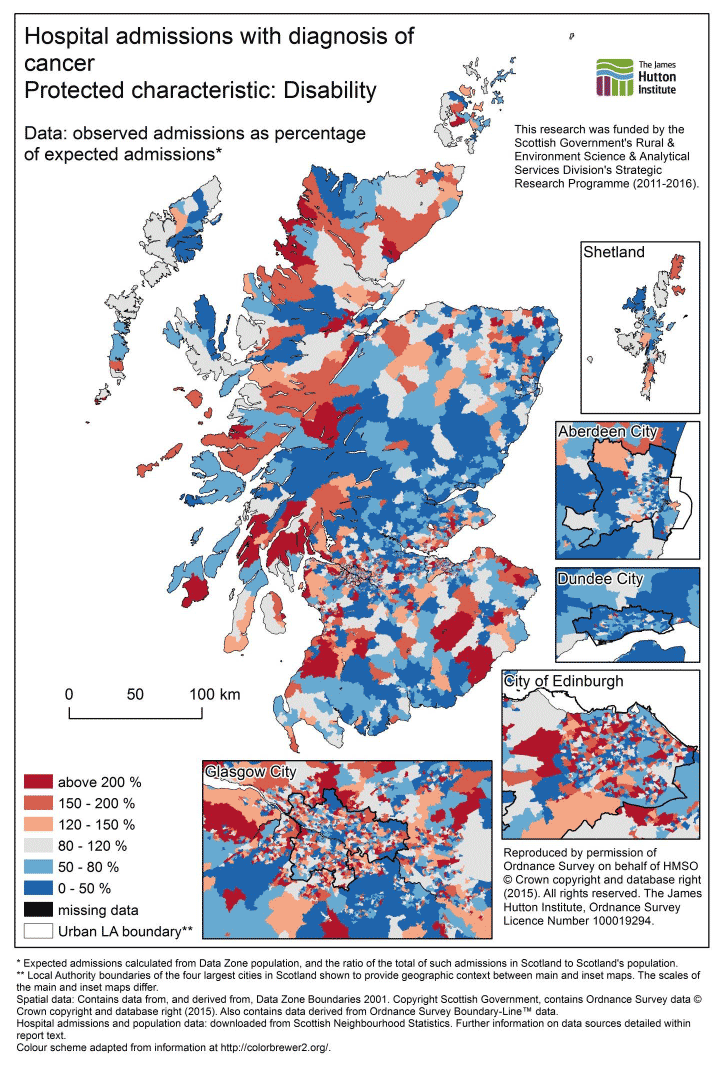
Number of new cancer registrations
Table B.8.: Number of new cancer registrations.
| Region | Total population | New cancer registrations | New cancer registrations (% of expected) | % of Scotland population | % of Scotland's new cancer registrations |
|---|---|---|---|---|---|
| Very Remote Rural | 160,365 | 4,986 | 113.76 | 3.07 | 3.49 |
| Remote Rural | 181,114 | 5,280 | 106.67 | 3.46 | 3.69 |
| Accessible Rural | 625,059 | 16,051 | 93.96 | 11.95 | 11.23 |
| Very Remote Small Towns | 67,949 | 2,005 | 107.97 | 1.30 | 1.40 |
| Remote Small Towns | 124,158 | 4,078 | 120.18 | 2.37 | 2.85 |
| Accessible Small Towns | 455,450 | 12,867 | 103.37 | 8.71 | 9.00 |
| Other Urban Areas | 1,601,523 | 43,260 | 98.83 | 30.61 | 30.25 |
| Large Urban Areas | 2,016,282 | 54,462 | 98.83 | 38.54 | 38.09 |
The number of new cancer registrations in the 2005-2009 period (Table B.8.) were above expected values for remote and very remote rural areas and small towns, and were particularly over-represented in remote small towns (20% above expected values). This pattern is therefore similar to that for the hospital admissions data. Also in common with the hospital admissions data, accessible rural areas appear particularly 'healthy' by this indicator, and while urban areas recorded a large majority of all new cancer registrations, the numbers of registrations recorded in these areas were not above expected numbers. Figure B.9. shows groupings of data zones where numbers of new cancer registrations were well above average in more remote areas, including the far south west, locations on the Solway coast, Arran, and parts of Skye, the Western Isles and the far north. Areas which are associated with below expected numbers of cancer registrations include Aberdeenshire, the southern edge of the central belt and the Shetland mainland. The large urban local authorities show a mixed picture.
Figure B.9.: Number of new cancer registrations, Scotland.
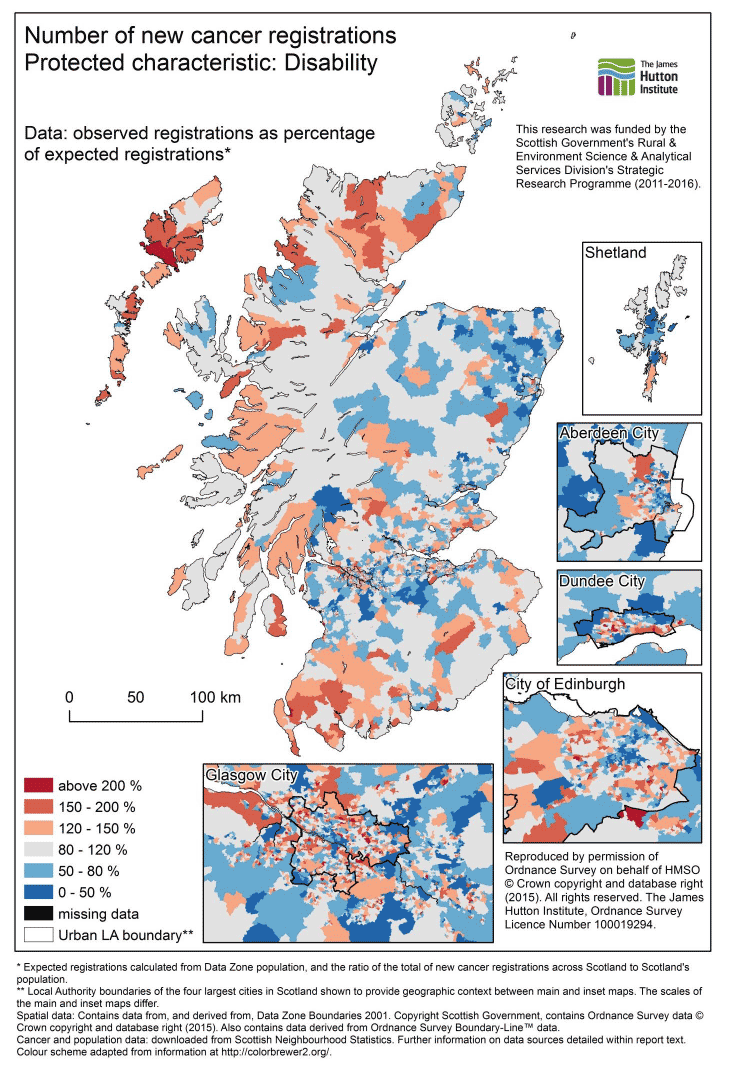
Male and female claimants of Attendance Allowance
Table B.9.: Male and female claimants of Attendance Allowance.
| Region | Male claimants of AA* | Female claimants of AA* | Male claimants of AA (% of expected) | Female claimants of AA (% of expected) | Male claimants of AA (% of male 65 or over population) | Female claimants of AA (% of female 65 or over population) | % of Scotland population | % of Scotland population - male claimants of AA | % of Scotland population - female claimants of AA |
|---|---|---|---|---|---|---|---|---|---|
| Very Remote Rural | 1,765 | 3,525 | 112.99 | 109.65 | 10.26 | 18.00 | 3.03 | 3.41 | 3.32 |
| Remote Rural | 1,810 | 3,280 | 101.82 | 89.66 | 9.88 | 15.90 | 3.44 | 3.50 | 3.08 |
| Accessible Rural | 5,205 | 9,685 | 83.35 | 75.37 | 9.56 | 15.66 | 12.09 | 10.06 | 9.11 |
| Very Remote Small Towns | 775 | 1,755 | 117.23 | 129.00 | 13.56 | 22.54 | 1.28 | 1.50 | 1.65 |
| Remote Small Towns | 1,425 | 3,110 | 118.03 | 125.17 | 11.58 | 18.96 | 2.34 | 2.76 | 2.92 |
| Accessible Small Towns | 4,595 | 9,290 | 103.56 | 101.74 | 12.05 | 18.98 | 8.59 | 8.89 | 8.74 |
| Other Urban Areas | 15,995 | 32,675 | 101.90 | 101.16 | 13.02 | 20.28 | 30.40 | 30.93 | 30.73 |
| Large Urban Areas | 20,145 | 43,010 | 100.50 | 104.27 | 15.04 | 23.07 | 38.82 | 38.95 | 40.45 |
* Note that the regional numbers of claimants are summed from Data Zone-level figures for the fourth quarter of 2012 which were rounded from actual values.
Across Scotland, the number of female claimants of Attendance Allowance (106,330) was over double the respective male total (51,715). Table B.9. shows that numbers of female claimants were well above expected in remote and very remote small towns, above expected in very remote rural areas, but below average in remote rural areas and far below average in accessible rural areas. For male claimants, the pattern is similar, with total male Attendance Allowance claimants furthest above expected numbers in remote and very remote small towns and furthest below the expected in accessible rural areas. For men, differences between observed and expected numbers of claimants were smaller in these areas than for women. The spatial distribution of data zones where the number of Attendance Allowance claimants was far above expected differ for men and women: for male claimants, such data zones are more prominent in more remote areas (the west coast and islands near it, far south west, parts of the Highlands around Fort William and the Moray Firth coast) than for female claimants (Figures B.10. and B.11.).
Figure B.10.: Male claimants of Attendance Allowance, Scotland.
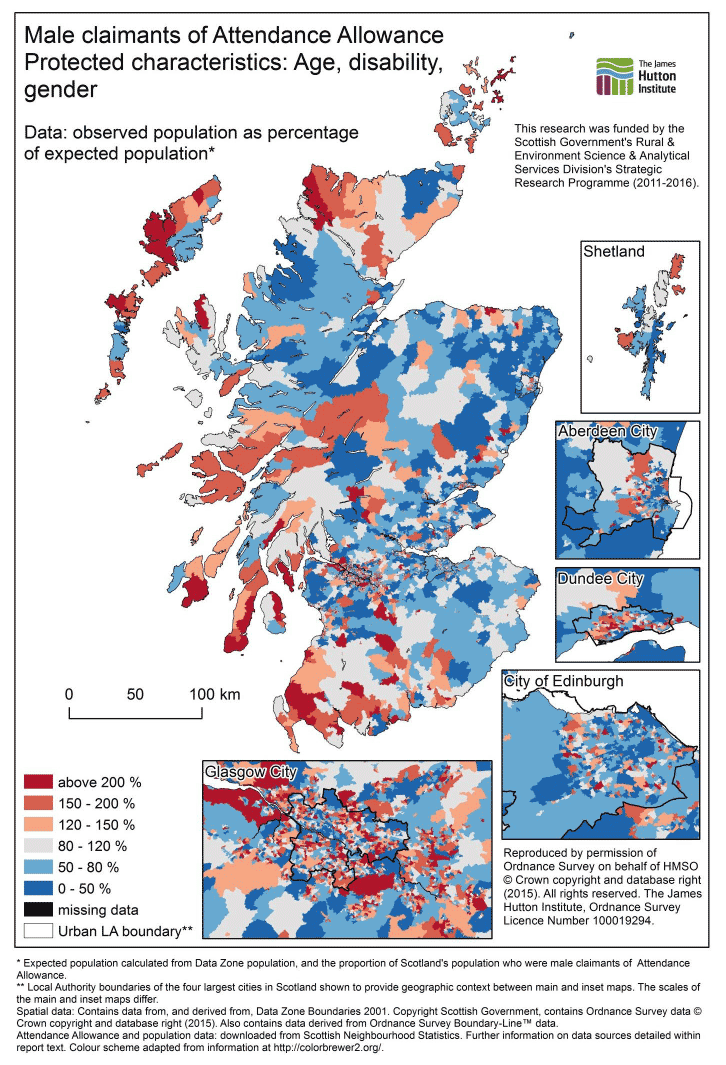
Figure B.11.: Female claimants of Attendance Allowance, Scotland.
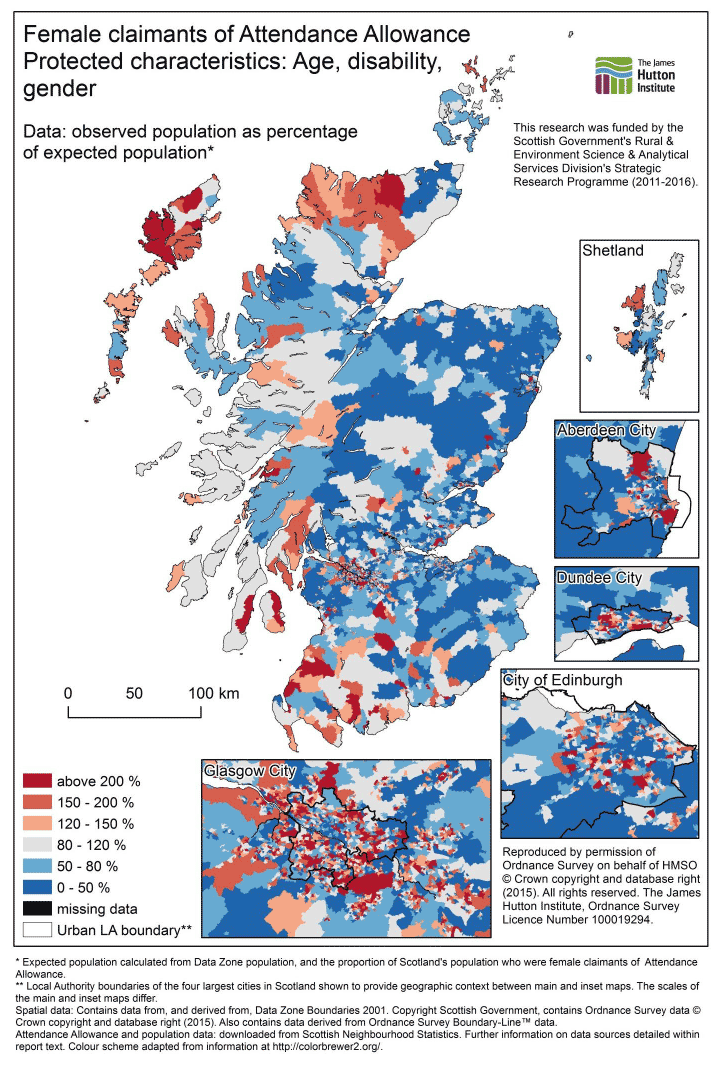
Contact
Email: Graeme Beale, socialresearch@gov.scot
There is a problem
Thanks for your feedback